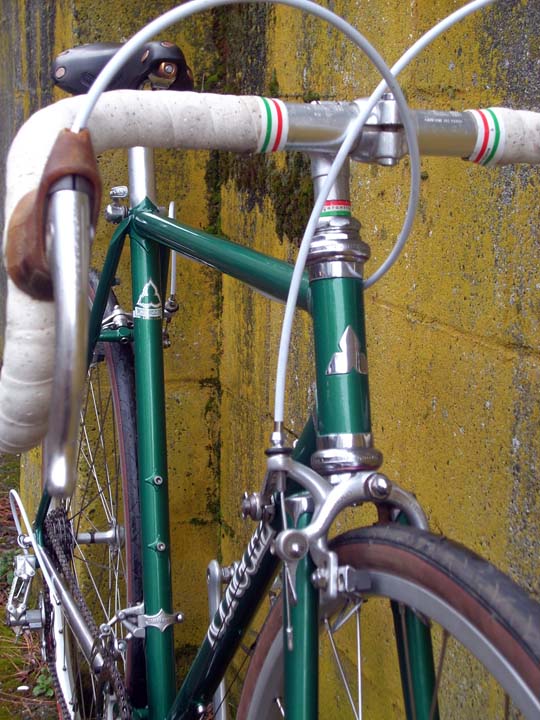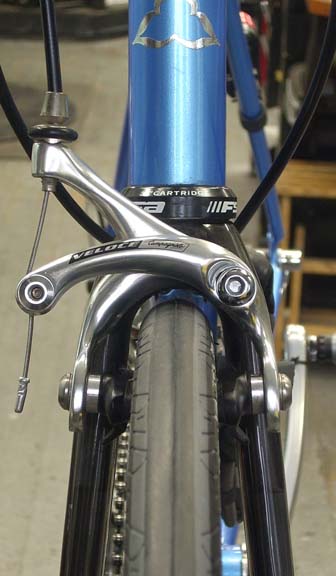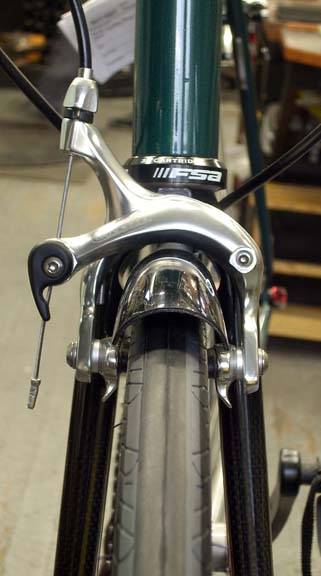
There's a good Reason for the Rodriguez Rainier Fork:
Some people think we made our own fork to save money. Not true. We developed the Rainier fork because fork manufacturers didn't offer one that customers wanted.
Ahhh the good old days
Remember the good old days when you could buy a sweet racing bike, install wide tires, and even a set of fenders for your daily commute? The best of both worlds: the lightweight performance of a racer coupled with comfort and durability. Well, those days are gone. A modern race bike won’t accept full fenders and, in many cases, won't even accept wider tires.
We struggled for years, just like our customers, trying to install fenders and wider tires onto their new race bikes. Cutting and zip tying were common methods. Eventually, the industry produced a scaled-down version of fenders that attached to the frame with rubber bands. We called them “race fenders,” but they were really pretend fenders—to keep some of the crud from hitting your riding buddies. Unfortunately, we were now in the hands of the carbon fork designers who limited tire widths, fender clearance, and even frame geometry. While most manufacturers caved in and conformed, Rodriguez Bikes said, "Enough already!" We designed and commissioned our own custom carbon fiber fork, the one cyclists were demanding—the Rainier Fork..
Why? What's the problem?
Start with the brakes. A wider tire and/or fenders require brakes with a slightly longer reach than standard racing brakes. They look just the same; they work just as well, but they provide a bit more clearance than short-reach racing brakes. To use these brakes, the manufacturer must position the brake bridge (where the brake mounts to the frame) a little higher. They also have to use a fork with a little more clearance at the point where the tire and fender pass through it.
At Rodriguez, we've always had control over the frame, so we could place the brakes at any height we wanted. Most companies don't make their own bicycles, so it's not possible. But for us....no problem.
Forks, on the other hand, were completely different. We, like everyone else, relied on the industry to deliver the goods. Well, the industry failed. Although our customers want a lightweight carbon fork, they also want wider tires and sometimes fenders. Alpha Q, Easton, Reynolds, Wound-up, etc., didn't even have that item on their radar (not to mention options for smaller bikes with 650 wheels). Carbon forks got to a point where they wouldn't accept a fender under any circumstance; even a 28mm tire was an issue if it was a wide 28mm.
Rodriguez Bicycles to the rescue!
We kept running into customers who wanted a race bike, but also wanted to run 28mm or wider tires. Out here in Seattle, fenders are required on many group rides, so the ability to install them is quite convenient too. This is why we spent the time and money to design and have our own carbon fork manufactured. Very few (if any) small frame builders go to this trouble for their customers.
Specs:
- Axle to Crown = 382mm
- Fork Rake = 50mm
- 1 1/8" Steering Tube = 350mm
- Designed for brake reach 47-57
Originally, it was more expensive to make the Rainier fork than to just order the Alpha Q or Profile models. But once we had the mold and went through several orders of the forks, the cost began to drop; now it's actually a less expensive option. It's the only carbon fork on the market that accommodates up to 32c tires on both 700c and 650c bikes. It even comes with threaded eyelets on the dropout so you don't have to put clamps on your carbon fork when you install fenders.
We spec'd the Rainier fork a little heavier so that we could offer a real warranty on it—as we do everything else we make. We're using an aluminum steering tube instead of carbon for durability. Most carbon-carbon forks are warranted for only a few years. We built the Rainier fork so that someone could ride with confidence much longer.
The Rainier carbon fork is only available with purchase of a Rodriguez Rainier bike.




